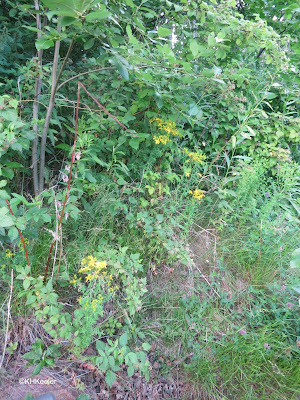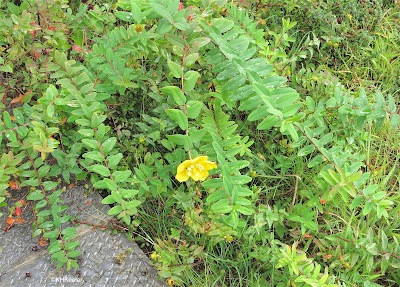Today, you mostly hear of St. John's wort (Hypericum perforatum, St. Johns wort family, Hypericaceae) as a medicinal plant. It has been shown to be effective treating depression, anxiety, and sleep disorders and is widely used for those. But when I studied ecology in graduate school in the 1970s, under its American name, Klamath weed, it was the weed in a major weed-control story. So here are both tales.
 |
| St. John's wort, Klamath weed, Hypericum perforatum |
St. John's wort is native to Europe, western Asia and North Africa and has been a medicinal plant there for millennia. Common names include common St. John's wort, perforate St. John's wort (you can spell it Johnswort), Klamath weed, amber, goatweed, rosin-rose, chase-devil, and Tipton weed. It was thought to have important warding powers, so was hung over doorways and religous figures as protection from evil. Likewise it was believed to keep you safe from both fairies and the devil. And to save you from or cure poisons including snake bites. People in the Hebrides were wearing St. John's wort into the 20th century to keep away enchantments, witchcraft, and death, though it was not considered effective unless the plant was accidentally found (which made a happy moment!).
It was hung about the house to ward off lightning.
The yellow flowers have made it a sun symbol since ancient times. It was sacred to Baldur, god of the sun and summer in Norse mythology. Furthermore, it comes into bloom about midsummer. The name St. John's wort is because St. John the Baptist's birthday is accepted as June 24, six months before Christ's (old Roman calendar). That coincided with the summer solstice. Consequently St. John's Eve (June 23) and the Feast of St. John (June 24) were major holidays in Christian Europe, sometimes called summer Christmas. They were attended by the appearance of flowers on St. John's wort (wort means medicinal plant). So this yellow sun-like flower welcomed the solstice, and celebrated the birth of a famous saint. Of course it was widely used in the festivals of the solstice/Saint John's day.
It has rich European folklore. For example, if a young girl picked a sprig of St. Johnswort on St. John's Eve she would know she was likely to marry if it was still fresh in the morning. If a person slept with it under his or her pillow on St. John's Eve, the saint would appear in a dream, give his blessing, and prevent them from dying in the coming year.
As a medicine it was believed to heal cuts, grow hair, treat colic, sooth burns, kill intestinal worms, and clear the lungs. Some of the treatments are not supported by modern science, but historically it was so well-regarded that it was used practically as a universal medicine.
 |
St. John's wort as a weed in a field,
Stockton, California
|
Naturally a plant this wonderful was brought to North America. In the Pacific Northwest, it quickly escaped to become not just a weed, but a major weed, covering acres of ground. Westerners called it Klamath weed, since an early infestation was near the Klamath River. It spread. Not only did it reduce forage in pastures, but when livestock eat it, they lose weight. They often develop skin irritation and hypersensitivity to light. (Consuming St. John's wort can cause skin irritation and photosensitivity in humans as well, but the quantities used in medicine are tiny). By 1944 it covered two million acres across thirty California counties. Ranchers couldn't make a living and their land lost its value. The area was too big for herbicides to be practical, so California weed control scientists tried what was then a new approach, introducing insects that eat the plant. That was a dramatic success. The vast expanses of St. John's wort were reduced 99% in 10 years, until it could only be found as small clumps in shaded, isolated areas. Control is not perfect and it remains a threat in the West. It is currently listed as a noxious weed in eight western states and can be found as a weed in most U.S. states and Canadian provinces (
map)
So it is both a major protective herb and a terrible weed.
St. John's wort is a woody shrub that can grow three feet high. The flowers are bright yellow and distinctive for the spray of anthers above the five petals. The leaves are oval, arranged opposite each other, and dotted with what look like tiny holes if you hold the leaf up to the light. That is what "perforatum" refers to in the scientific name, and is a good character for telling common St. John's wort, Hypericum perforatum, from other species of Hypericum, many of which have been introduced to the United States as ornamentals because of the handsome flowers. The holes are actually tiny clear glands that contain the active chemical of St. John's wort, hypericin.

The name Hypericum, given to this plant by Linnaeus when setting up the scientific name system, is Greek for hyper meaning above and eikon meaning picture, referring to the practice of hanging the flowers above images or windows. I have seen that also translated as "over an apparition" with much the same meaning. Alternately, Hypericum could mean "over heath" hyper plus ereike "heath" indicating it grows "over the heath (uncultivated land)." I don't know Greek and cannot judge these alternatives, except to say everyone is repeating the first one these days. The authorities I read hedged on the identification of the Greek plant--maybe it wasn't our Hypericum perforatum--but agreed that Hypericum perforatum had many of the same traditional uses in Europe as the ancient Greek Hypericum. My source for plant families, the Angiosperm Phylogeny website, puts St. John's wort in its own family, Hypericaceae, but previously it was in the larger Clusiaceae.
One last piece of St. John's wort folklore: on the Isle of Wight you were warned that if you stepped on the plant after dark, a phantom horse would emerge from the plant's roots, rising with you on its back, and gallop away, running the whole night long and, ultimately, leaving you far from home to make your own way back.
 |
St. John's wort flowers
|
Comments and corrections welcome.
Kathy Keeler, A Wandering Botanist
More at awanderingbotanist.com
Join me on Facebook: https://www.facebook.com/AWanderingBotanist
Sources
Durant, M. 1983. Who Named the Daisy? Who Named the Rose? Condone & Weed, Inc., New York, New York.
Hypericum perforatum. Missouri Plant Finder
link Accessed 8/30/2020.
Legner, E.F. 1966. Klamath weed.
linkKlamath weed. 2012. The Nature Niche blog
link Accessed 8/29/2020.
Vickery, R. 1997. Oxford Dictionary of Plant-Lore. Oxford University Press, Oxford.





Wonderful, thank you. I will be thinking of all this history the next time I see St.John's wort!
ReplyDeleteHi!
ReplyDeleteI am very happy to have discovered your blog while looking for some info on Klamath weed.
I've always loved learning about ethnobotany and your posts are very informational!
I also see that you've read Braiding Sweetgrass by Professor Kimmerer. I took classes with her as my Professor in Syracuse college and LOVE her book.
I'll be looking forward to your posts :)